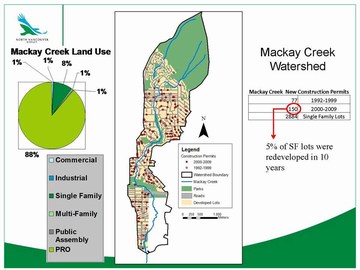District of North Vancouver experience in applying the Water Balance Model to develop a watershed restoration vision
Note to Readers:
The purpose of Day 2 of the 'From Rain to Resource Workshop on October 29 is to integrate the perspectives of the people working on the ground and those developing and adopting policy. A featured case study is the policy framework that will enable the District of North Vancouver to achieve a watershed restoration vision.
Richard Boase, Environmental Protection Officer with the District of North Vancouver and Co-Chair of the Inter-Governmental Partnership, will elaborate on how his municipality is applying the Water Balance Model for British Columbia to develop the policy framework.
Making Informed Political Decisions
 “A key message from the District of North Vancouver experience is that Council is making informed decisions based on information derived from use of the Water Balance Model. Currently, District staff members are meeting with our politicians in a series of Council Policy Workshops discussing the function of trees on private lands,” states Richard Boase.
“A key message from the District of North Vancouver experience is that Council is making informed decisions based on information derived from use of the Water Balance Model. Currently, District staff members are meeting with our politicians in a series of Council Policy Workshops discussing the function of trees on private lands,” states Richard Boase.
Mackay Creek Case Study
“Using the Mackay Creek Watershed as a case study, we have demonstrated to Council that the importance of hydrologic function associated with lands removed from the stream corridors is not only being overlooked but is contributing to the erosion of stream health. An improved water balance on the individual lot can be shown to arguably provide more benefit to improvements in stream health than the thin riparian strips that we zealously protect.”
To Learn More:
To read the complete story posted on the Rainwater Management Community-of-Interest, click on District of North Vancouver experience in applying the Water Balance Model to develop a watershed restoration vision

Posted October 2010

